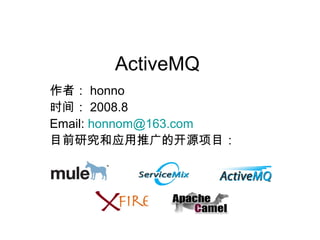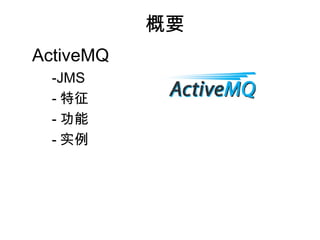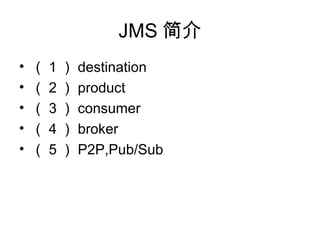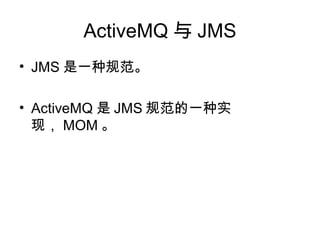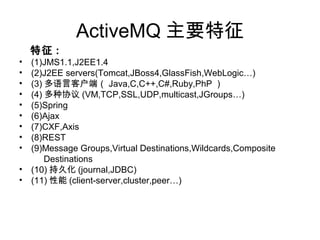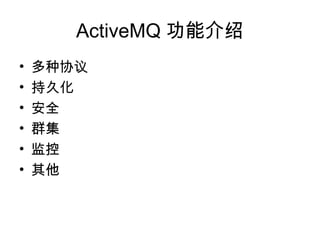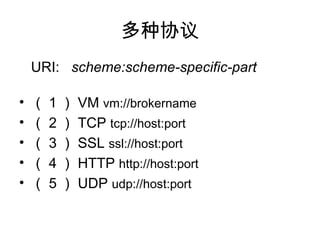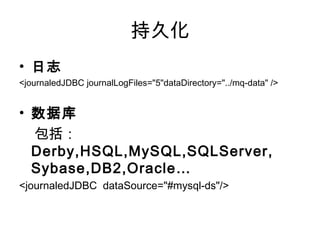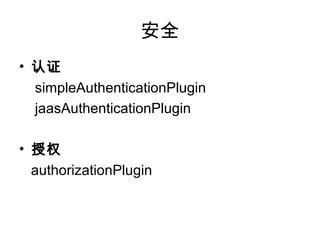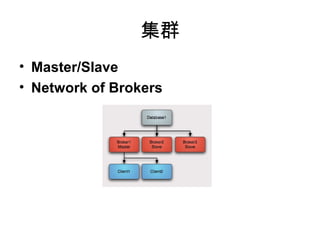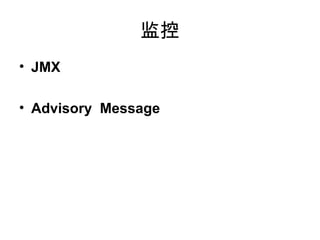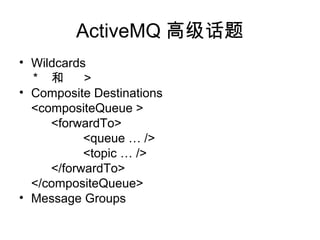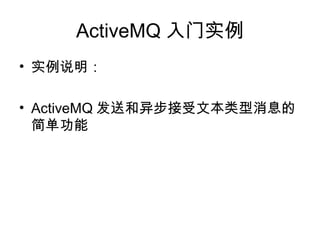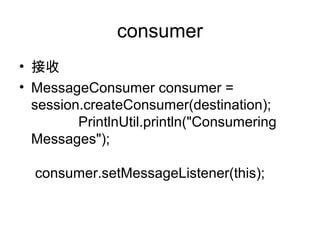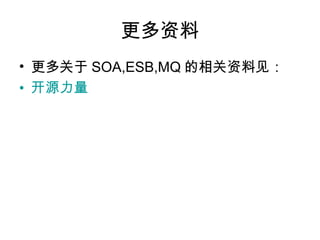Active Mq JMS
- 1. ActiveMQ 作者: honno 时间: 2008.8 Email: honnom@163.com 目前研究和应用推广的开源项目:
- 4. JMS 介绍 ? ( 1 ) destination ? ( 2 ) product ? ( 3 ) consumer ? ( 4 ) broker ? ( 5 ) P2P,Pub/Sub
- 5. ActiveMQ 与 JMS ? JMS 是一种规范。 ? ActiveMQ 是 JMS 规范的一种实 现, MOM 。
- 7. ActiveMQ 主要特征 特征 : ? (1)JMS1.1,J2EE1.4 ? (2)J2EE servers(Tomcat,JBoss4,GlassFish,WebLogic…) ? (3) 多语言客户端( Java,C,C++,C#,Ruby,PhP ) ? (4) 多种协议 (VM,TCP,SSL,UDP,multicast,JGroups…) ? (5)Spring ? (6)Ajax ? (7)CXF,Axis ? (8)REST ? (9)Message Groups,Virtual Destinations,Wildcards,Composite Destinations ? (10) 持久化 (journal,JDBC) ? (11) 性能 (client-server,cluster,peer…)
- 8. ActiveMQ 功能介绍 ? 多种协议 ? 持久化 ? 安全 ? 群集 ? 监控 ? 其他
- 9. 多种协议 URI: scheme:scheme-specific-part ? ( 1 ) VM vm://brokername ? ( 2 ) TCP tcp://host:port ? ( 3 ) SSL ssl://host:port ? ( 4 ) HTTP http://host:port ? ( 5 ) UDP udp://host:port
- 10. 多种协议 ? ( 6 ) peer peer://group/brokername ? ( 7 ) multicast multicast://IPAddress ? ( 8 ) static static(list uris) ? ( 9 ) failover failvoer(list uris) ? ( 10 ) discovery discovery://host:port
- 11. 持久化 ? 日志 <journaledJDBC journalLogFiles="5"dataDirectory="../mq-data" /> ? 数据库 包括: Derby,HSQL,MySQL,SQLServer, Sybase,DB2,Oracle… <journaledJDBC dataSource="#mysql-ds"/>
- 13. 集群 ? Master/Slave ? Network of Brokers
- 14. 监控 ? JMX ? Advisory Message
- 15. ActiveMQ 高级话题 ? Wildcards * 和 > ? Composite Destinations <compositeQueue > <forwardTo> <queue … /> <topic … /> </forwardTo> </compositeQueue> ? Message Groups
- 16. ActiveMQ 入门实例 ? 实例说明: ? ActiveMQ 发送和异步接受文本类型消息的 简单功能
- 17. broker ? 启动 ? BrokerService broker = new BrokerService(); try { broker.addConnector("tcp://localhost:61616"); broker.start(); } catch (InterruptedException e) { e.printStackTrace(); } catch (Exception e) { e.printStackTrace(); }
- 18. producer ? 发送 : 生产 10 个文本消息,并发送 . ? MessageProducer producer = ? session.createProducer(destination); TextMessage message ? =session.createTextMessage(); for (int i = 0; i < 10; i++) { message.setText("This is message " + ? (i + 1)); producer.send(message); }
- 19. consumer ? 接收 ? MessageConsumer consumer = session.createConsumer(destination); PrintlnUtil.println("Consumering Messages"); consumer.setMessageListener(this);
- 21. 更多资料 ? 更多对于 SOA,ESB,MQ 的相关资料见: ? 开源力量
- 22. 谢 谢
